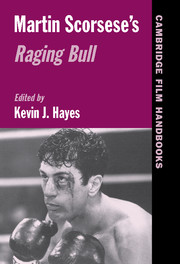Book contents
- Frontmatter
- Contents
- List of Illustrations
- List of Contributors
- Abbreviations
- Introduction: The Heritage and Legacy of Raging Bull
- 1 Art and Genre in Raging Bull
- 2 Visual Absurdity in Raging Bull
- 3 Raging Bull and the Idea of Performance
- 4 Women in Raging Bull: Scorsese's Use of Determinist, Objective, and Subjective Techniques
- 5 My Victims, My Melancholia: Raging Bull and Vincente Minnelli's The Bad and the Beautiful
- REVIEWS OF RAGING BULL
- Filmography
- Select Bibliography
- Index
Introduction: The Heritage and Legacy of Raging Bull
Published online by Cambridge University Press: 24 November 2009
- Frontmatter
- Contents
- List of Illustrations
- List of Contributors
- Abbreviations
- Introduction: The Heritage and Legacy of Raging Bull
- 1 Art and Genre in Raging Bull
- 2 Visual Absurdity in Raging Bull
- 3 Raging Bull and the Idea of Performance
- 4 Women in Raging Bull: Scorsese's Use of Determinist, Objective, and Subjective Techniques
- 5 My Victims, My Melancholia: Raging Bull and Vincente Minnelli's The Bad and the Beautiful
- REVIEWS OF RAGING BULL
- Filmography
- Select Bibliography
- Index
Summary
Martin Scorsese's Raging Bull (1980) represents American filmmaking at its best. Since its initial release, the film has garnered a significant critical reputation. It has been called the greatest film of the 1980s, the greatest boxing film ever made, the greatest sports film ever made, and, indeed, one of the greatest films of all time. Superlatives abound whenever people talk about Raging Bull. Not only is it an exemplary cinematic work, it is also a cultural icon representing a rich cross section of themes, issues, and characters that reflect American culture in ways that typical Hollywood films do not. Furthermore, Raging Bull is a highly personal film. It reflects Scorsese's unique personal vision, captures the personality of the brutal but all-too-human Jake La Motta, and perpetuates the intimate working relationship between Scorsese and his star Robert De Niro.
Around the time Scorsese was making Alice Doesn't Live Here Anymore (1974), De Niro gave him a copy of Raging Bull, the autobiography of Jake La Motta, which La Motta co-wrote with Joseph Carter, a miscellaneous writer, and Peter Savage, a longtime friend who figures prominently in the book as Pete, a partner in Jake's early criminal activities and in his subsequent success in boxing. Later becoming acquainted with Savage, Scorsese found him to be “an amazing character.” Scorsese generally enjoyed reading La Motta's autobiography, but it seemed to him that Savage was most responsible for its content.
- Type
- Chapter
- Information
- Martin Scorsese's Raging Bull , pp. 1 - 18Publisher: Cambridge University PressPrint publication year: 2005



